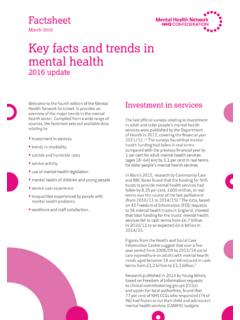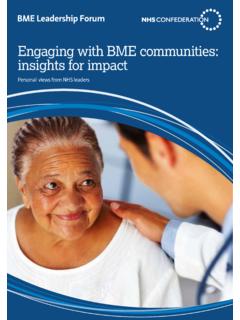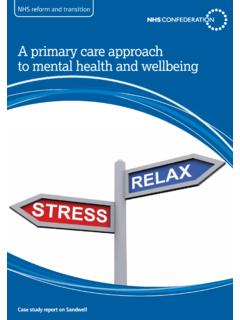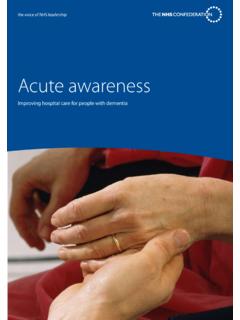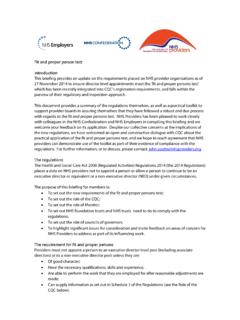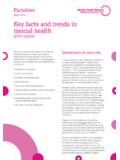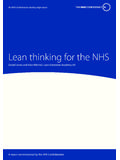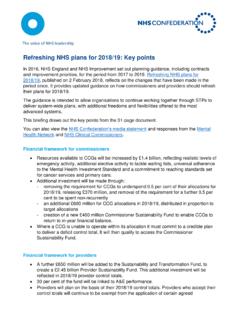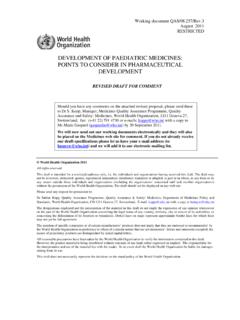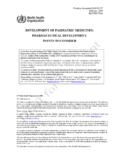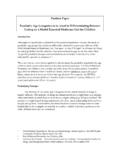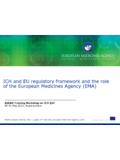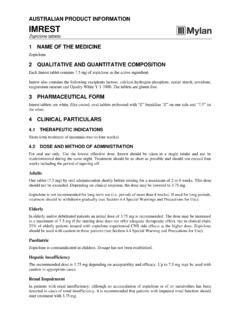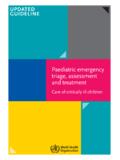Transcription of Brexit and the impact on patient access to medicines and ...
1 January 2018 BriefingBrexit and the impact on patient access to medicines and medical technologiesThe UK s plans to leave the European Union (EU) and the EU s single market could have serious implications for patients access to medicines and medical technologies. This briefing explores how UK and EU citizens could be affected by the disruption in trade that could result from the UK s exit from the EU, as well as in the event of lack of cooperation in the regulation of medicines and devices between the EU and the UK post Brexit . The regulation of medicines and medicaltechnologies is managed by EU-wide systems,facilitating trade under the single marketThis means that products are regulated tomake sure that they are safe before theycan be placed on the EU market.
2 They arealso closely monitored after being placed onthe market to ensure continued safety. The regulatory arrangements for medicinesand medical devices are complex and changesto this regime may have an impact on suppliesacross Europe. No deal or a deal betweenthe UK and the EU that does not addressfuture cooperation on medicines and medicaltechnologies could put public health at risk. As the EU and the UK are making plansto move to phase two of the Article 50negotiations, which looks at the futurerelationship between the EU and the UK, it iscritical that arrangements for the regulationof medicines and medical devices shouldbe addressed as a matter of the Brexit Health Alliance is calling for: No negative impact on patients.
3 Futurecooperation on medical devices and medicinesto be prioritised in the negotiations, so thatpatients and the wider public are not negativelyimpacted from disruptions in the supply ofmedicines and other health technologies, orfrom a reduction in standards or safety. patient safety and public health to be guaranteedpost Brexit through aligning the UK as muchas possible with the EU s regulation ofmedicines and medical devices, and by closeregulatory cooperation between the EU andUK, as proposed by the UK Pragmatic solutions allowing patients and thepublic to benefit from the UK s participationin EU systems such as data sharing networks,pharmacovigilance and the new clinicaltrials infrastructures post Brexit .
4 An implementation period beyond the two yearsof Article 50 negotiations (which end in March2019). This period should adequately reflectthe time needed to ensure relevant customs,trade and regulatory procedures are in has EU regulation on medicines and medical technologies benefited patients? The primary benefit of a harmonised EU regulation for medicines and medical technologies is that patients are guaranteed a high level of safety. All medicines and medical products on the EU market must be of a high standard, and most importantly, proven to be safe and efficacious (or performing as intended in the case of devices) before they can be placed on the market in the EU.
5 This means that almost 500 million people in the EU benefit from these high standards, whilst also encouraging companies to research and develop medicines in the EU has also developed robust mechanisms for continued surveillance of products already on the market to ensure that they are safe. Patients benefit when countries can work together to map out adverse events, as it is easier to define trends and problems with more data and larger populations. For medical technologies, National Competent Authority Report exchange (NCAR) is the process whereby competent authorities such as the UK s medicines and Healthcare Products Regulatory Agency (MHRA) disseminate vigilance data.
6 Vigilance is thus a Europe-wide activity helping to ensure patient safety and consistency of actions across member states. Since 2012, there have been 4,785 NCARs across the medicines , this surveillance is called pharmacovigilance. The Pharmacovigilance Risk Assessment Committee (PRAC), established in 2013, plays a crucial role as a signalling system and makes recommendations on the management of For example, recommendations can include restrictions on use and advice on optimal use of medicines . This has been able to deliver more timely decision-making and to conduct major public health reviews on available regulatory frameworks at EU level have been crucial in providing patients with faster access to treatments.
7 In the global market, separate national systems of regulation of health technologies can slow down treatments for patients. This applies particularly to smaller patient groups which is why regulatory oversight across the EU brings particular added value for children and rare disease children, the 2006 EU Paediatric Regulation4 aims to promote high-quality research into the development of medicines for children. Specifically, it is designed to make sure that over time, most medicines used by children are tested and authorised for such use. It has the dual aim of obliging and incentivising industry to conduct paediatric clinical trials. It has certainly contributed to increased research in medicines for children in the EU with the number of children in registered clinical trials jumping from 3,648 to 211,302 in the period 2006 2015.
8 This 60-fold (6,000 per cent) increase represents a very significant growth in research about children funded by the pharmaceutical rare disease patients, the EU regulation on orphan medicines6 has incentivised the development of products intended for the diagnosis, prevention or treatment of life-threatening or very serious rare conditions. Taken together, between 6,000 and 8,000 rare diseases affect the daily lives of around 30 million people in the EU. To date the EU has authorised 141 orphan medicines , and designated 1,508 products as orphan medicines . Shared regulatory frameworks at EU level have been crucial in providing patients with faster access to treatments.
9 03 January 2018 Brexit and the impact on patient access to medicines and medical technologiesWhat is at risk if no solution for medicines and medical devices is found?Certain medicines and medical technologies may be delayed in reaching patients or may even become unavailable to patients if no solution for medicines and medical devices is found during the Brexit to new medicines and medical technologiesAs a result of the relocation of the European medicines Agency (EMA) to Amsterdam, the agency had to de-prioritise certain activities, such as its work on paediatric medicines and public health issues. This includes its work on anti-microbial resistance and flu pandemics.
10 While expertise will be developed over time, the loss of the UK s national competent authority, the MHRA, to the joint pool of expertise available under the EMA could be detrimental to the scientific approval of medicines for the EU market in the interim. In 2016, the MHRA led 20 per cent of scientific evaluations of new medicines for the for medical devices, it is estimated that around 50 per cent of the assessment work needed for the authorisation of products to be placed on the EU market takes place in the UK. There is already limited capacity in this area across Europe and any possible loss of capacity could clearly impact the availability of medical a time when there are more new medicines and medical devices than ever coming on the market, it would be regrettable for European patients to face delays in accessing new medicines due to delays in the European approval pipeline as companies launch their products first in Asia and the could also be additional delays for UK patients in accessing new medicines , as the experience of Switzerland, which is not a member of the EMA, shows.
